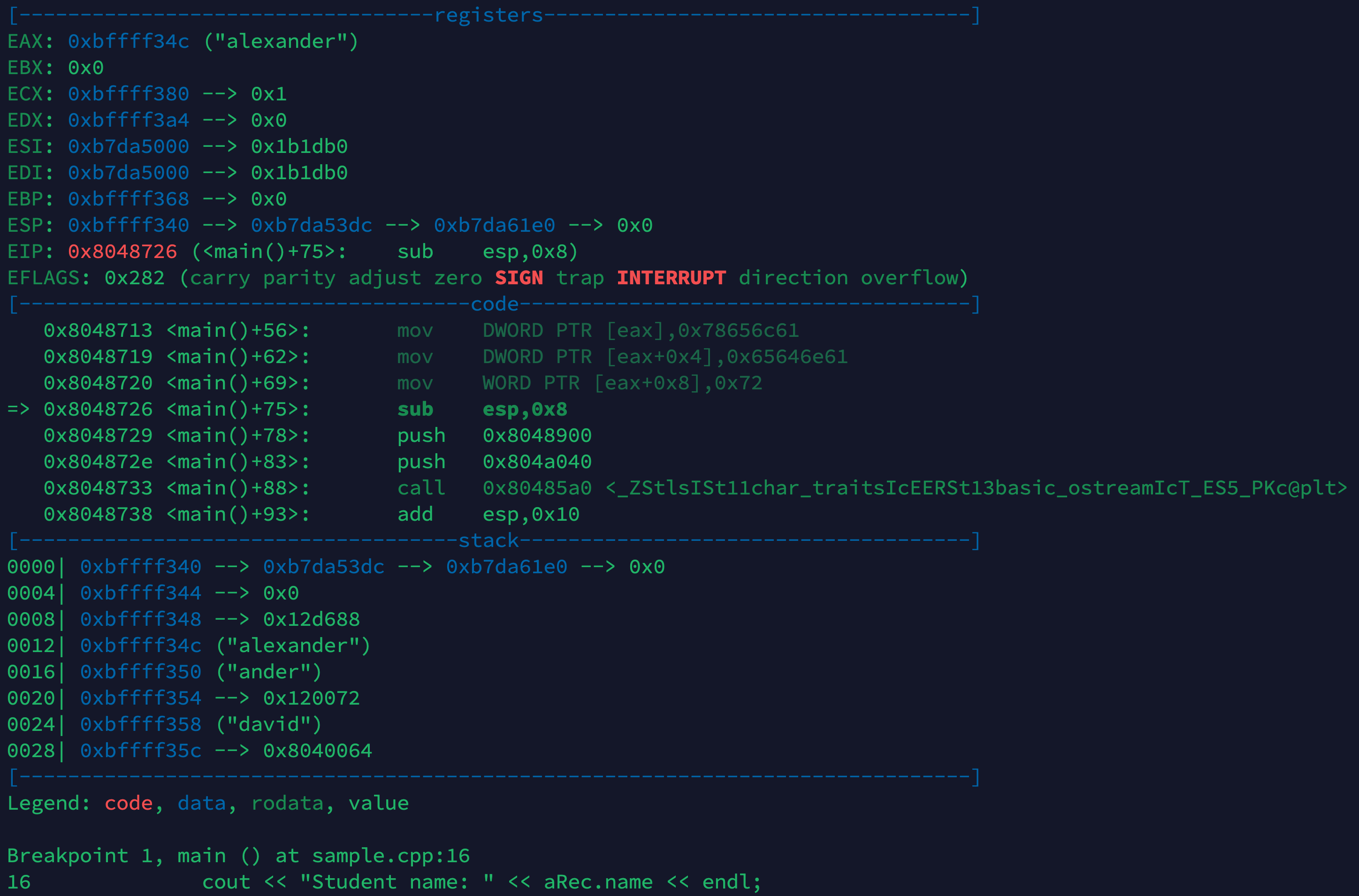[03/15/23]seed@VM:~$ sample
Student name: david
Student number: 1179762
Student name: alexander
Student number: 1234568The stacks of X86 and ARM grow towards lower addresses. The stack analysis is as below.
+ ...... +
+----------------+
+ main() +
+----------------+
+ ...... +
+----------------+ <-- Stack Top: Lower Address
+ bRec.sNumber +
+----------------+
+ bRec.name +
+----------------+
+ aRec.sNumber +
+----------------+
+ aRec.name +
+----------------+ <-- Bottom of the stack: Higher Adderss
+ ...... +if If only concerned with member variables, then
+----------------+ <-- Stack Top: Lower Address
+ bRec.sNumber[0]+
+----------------+
+ bRec.sNumber[1]+
+----------------+
+ bRec.sNumber[2]+
+----------------+
+ bRec.sNumber[3]+
+----------------+
+ bRec.name[0] +
+----------------+
+ bRec.name[1] +
+----------------+
+ bRec.name[2] +
+----------------+
+ bRec.name[3] +
+----------------+
+ bRec.name[4] +
+----------------+
+ bRec.name[5] +
+----------------+
+ bRec.name[6] +
+----------------+
+ bRec.name[7] + <-- Stack overflow
+----------------+
+ aRec.sNumber[0]+
+----------------+
+ aRec.sNumber[1]+
+----------------+
+ aRec.sNumber[2]+
+----------------+
+ aRec.sNumber[3]+
+----------------+
+ aRec.name[0] +
+----------------+
+ aRec.name[1] +
+----------------+
+ aRec.name[2] +
+----------------+
+ aRec.name[3] +
+----------------+
+ aRec.name[4] +
+----------------+
+ aRec.name[5] +
+----------------+
+ aRec.name[6] +
+----------------+
+ aRec.name[7] +
+----------------+ <-- Bottom of the stack: Higher AdderssNote that both the diagram above does not show the padding.
Obviously, the length of alexander exceeds 8, it will occupy the extra bytes of a Rec.sNumber.
I will analyze in detail why this phenomenon occurs.
seed@VM:~$ g++ -g -fno-stack-protector -o sample sample.cpp
seed@VM:~$ gdb sample
gdb-peda$ break 16 # Pause after strcpy and before output
gdb-peda$ run The outcome is as below
Viewing stack pointers and values:
gdb-peda$ print &aRec.sNumber
$1 = (int *) 0xbffff354
gdb-peda$ print &aRec.name
$2 = (char (*)[8]) 0xbffff358
gdb-peda$ print &bRec.sNumber
$3 = (int *) 0xbffff348
gdb-peda$ print &bRec.sNumber
$4 = (int *) 0xbffff348
gdb-peda$ print &bRec.name
$5 = (char (*)[8]) 0xbffff34c
gdb-peda$ print &aRec
$6 = (Student *) 0xbffff354
gdb-peda$ print &bRec
$7 = (Student *) 0xbffff348Next, check the bRec.name
- Original sequence -> Reverse order:0x0 0x12 0x0 0x72
- 00000000 00010010 00000000 01110010 (2) -> 1179762 (10)
Therefore 1179762 is shown.

